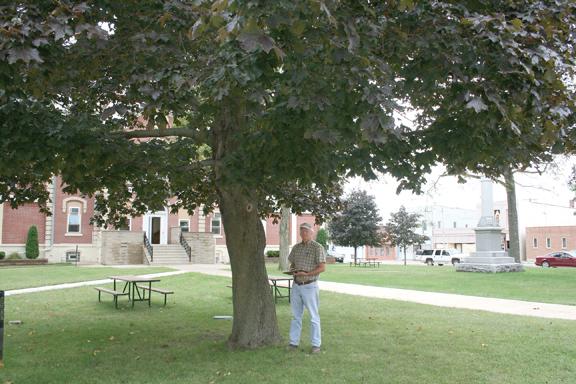
20 Sep Community Tree Inventories
On guard for ‘The Green Menace’
 Taking inventory of trees in Howard County
Taking inventory of trees in Howard County
By Keri Bugenhagen
News Editor, Cresco Times Plain Dealer
CRESCO – Lately, Iowans have been hearing about the looming threat of the emerald ash borer, also referred to as “The Green Menace.” According to the United States Department of Agriculture (USDA), this metallic green insect is an invasive beetle native to China and eastern Asia that is specifically destructive to all varieties of ash trees.
According to Iowa State University Extension, the beetle in its adult stage only causes “minor feeding damage to ash foliage.” However, in the larval stage, the pest “feeds beneath the bark and disrupts water and nutrient flow within the tree, which leads to tree death.”
For the first time last May the beetle, measuring about 1/2 inch long and 1/8 inch wide, was found beginning to wreak havoc on Iowa soil near New Albin in Allamakee County – a discovery made by the Iowa Emerald Ash Borer Team.
First found in southeastern Michigan, no one knows for sure how long the beetle has been around, although the USDA reports that the scientific community now believes the beetle has gone undetected on U.S. soil for about 12 years, based on the evaluations of ash tree destruction.

Richard Kittelson, Northeast Iowa Resource Conservation & Development Forestry Outreach Coordinator, has been part of the effort to survey local trees in order to thwart the potential upcoming destruction that might be caused by the emerald ash borer if it should soon move into the area. (Photo by Keri Bugenhagen)
While widespread sightings of the beetle remain to be seen in the area, Richard Kittelson, Northeast Iowa Resource Conservation & Development Forestry Outreach Coordinator, says it’s likely a matter of time before the beetle finds its way to Howard County.
Thus, in partnership with DNR Forestry, Kittelson has recently embarked on a mission to survey all street trees in the county. While publicly owned street trees are in the midst of being inventoried and evaluated, no private trees are to be included.
The project, funded by a grant from the USDA Forest Service allows the DNR to assist communities with a population under 5,000, stretching over 12 eastern Iowa counties.
According to Kittelson, not only does the grant allow for funding to be directed toward the street tree inventories, but also to aid in the development of comprehensive management plans that will be offered free-of-cost to participating communities.
Kittelson says there are a lot of trees in Cresco, therefore taking him a little longer to conduct tree inventories than he had first planned. “I think I’m looking at four to five days more,” he said last week. “I’ve got to say, I’ve gotten more questions from your community than any other community I’ve been in, which is good. It means people are paying attention.”
The tree surveying is meant to help communities in Howard County, as well as in other counties, determine what kind of trees are out there and what condition they’re in. And Kittelson says Cresco does have a high count of ash trees – a count that will be included in the management plan that will be released in the coming months.
State Urban Forester Emma Bruemmer, of the Iowa Department of Natural Resources, says the management plan will be released in an effort to help Howard County prevent the spread of the emerald ash borer and to prepare the community for the damage that may potentially be seen due to the arrival of the beetle. She says the plan will help the community respond more quickly to the pest.
Bruemmer says the plans will discuss the importance of street trees in many different areas, for example the role they play in cleaning the air. “It will also show where some of the unhealthy trees are in the urban forest, and how to remove ‘risk’ trees – trees that could endanger humans or property,” she said. “It shows where all the ash trees are and in the case of the emerald ash borer, where they are and if they need to be removed.”
Bruemmer says risk trees are found in any community. “It’s been hard to keep up with the storms we’ve had this year,” she said. “We do expect to see a lot of risk trees that need to be addressed.”
She notes that not only does eastern Iowa seem to have a large population of ash trees, but there is also a large population of maple trees – over 50 percent in some communities. “Maple trees are a concern in the long-term as we start to see more invasive pests,” she said, adding that the lack of tree diversity could be part of the problem.
For example, the Asian longhorn beetle is another invasive pest that destroys maple trees. “Looking into the future, we hope that showing communities that they have a large population of not only ash, but maple, they can start planting a more diverse forest for long-term health,” she said.
Plant substitutions for ash and maple trees include: native oaks such as red, white, bur, chinkapin, shingle or swamp white; American and little leaf lindens or basswood; hackberry; river birch; gingko; thornless and podless honeylocust; Kentucky coffeetree; black walnut; London planetree; hickories and northern pecan; katsura tree; hophornbeam; hornbeam; pagoda dogwood; Japanese tree lilac; black cherry; serviceberry; flowering crabapple and hybrid elms.
Bruemmer notes that the current economy is having an effect on the removal of risk trees in most communities, however, having already developed a management plan for the City of Postville. “In Postville we found out that in removing risk trees as well as ash trees as the ash borer hits, it would take about 26 years to completely remove them with the city’s current budget,” she said. “It’s not enough to address this problem.”
She adds that in Iowa if the emerald ash borer begins to affect communities like Cresco, there will not be a lot of time to address the issue. As ash trees begin to die off due to the pest, communities will likely only have one to three years to begin removing dead trees as they become an issue to public safety. “Because of lawsuits that can often occur, communities have no choice but to expand their budget and remove the dead trees,” Bruemmer said. “We want to get them to think ahead so they don’t have a large crisis, especially with public safety. It’s a delicate balance because trees provide so many wonderful things for us, especially public trees, but also there is a risk side to that.”


